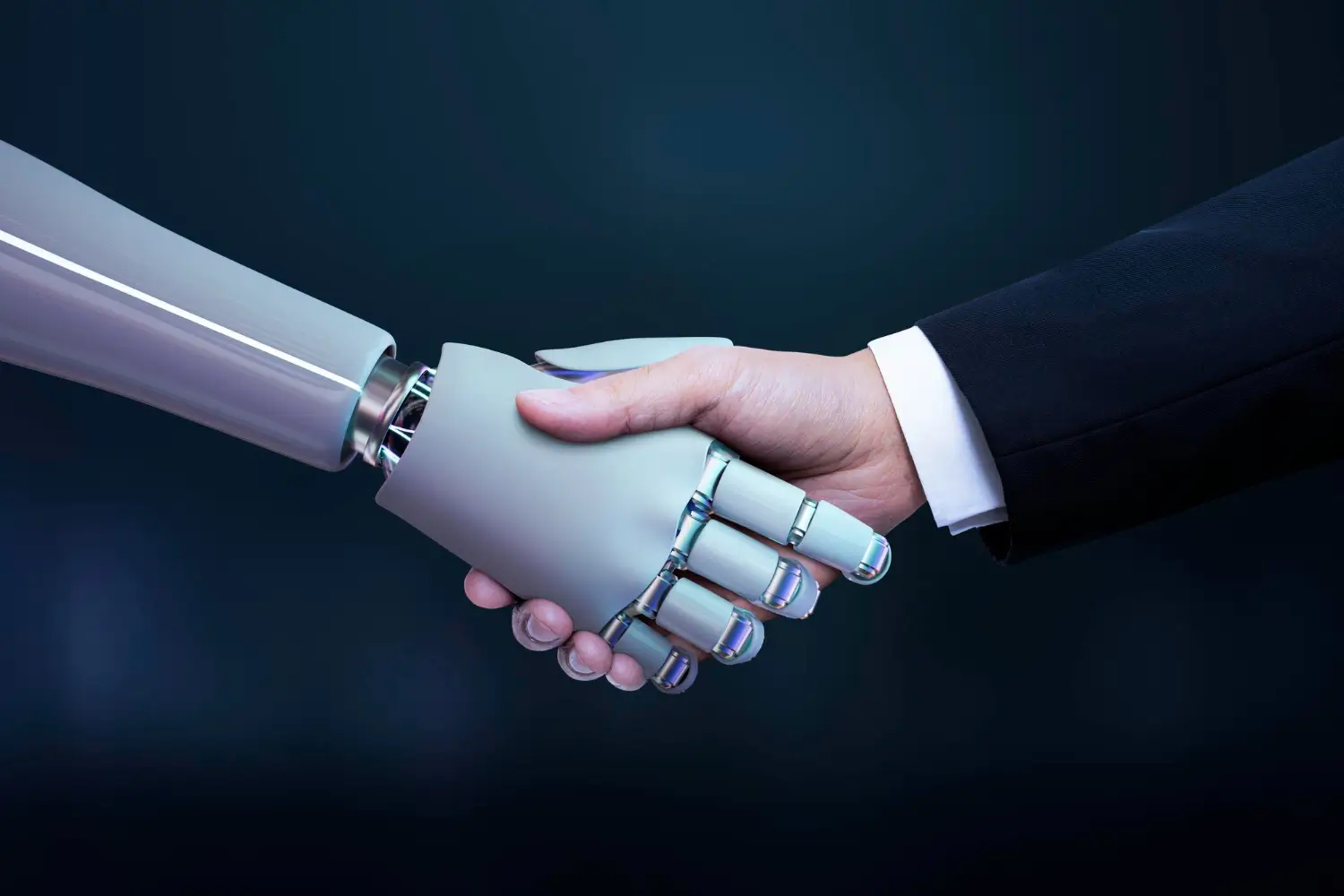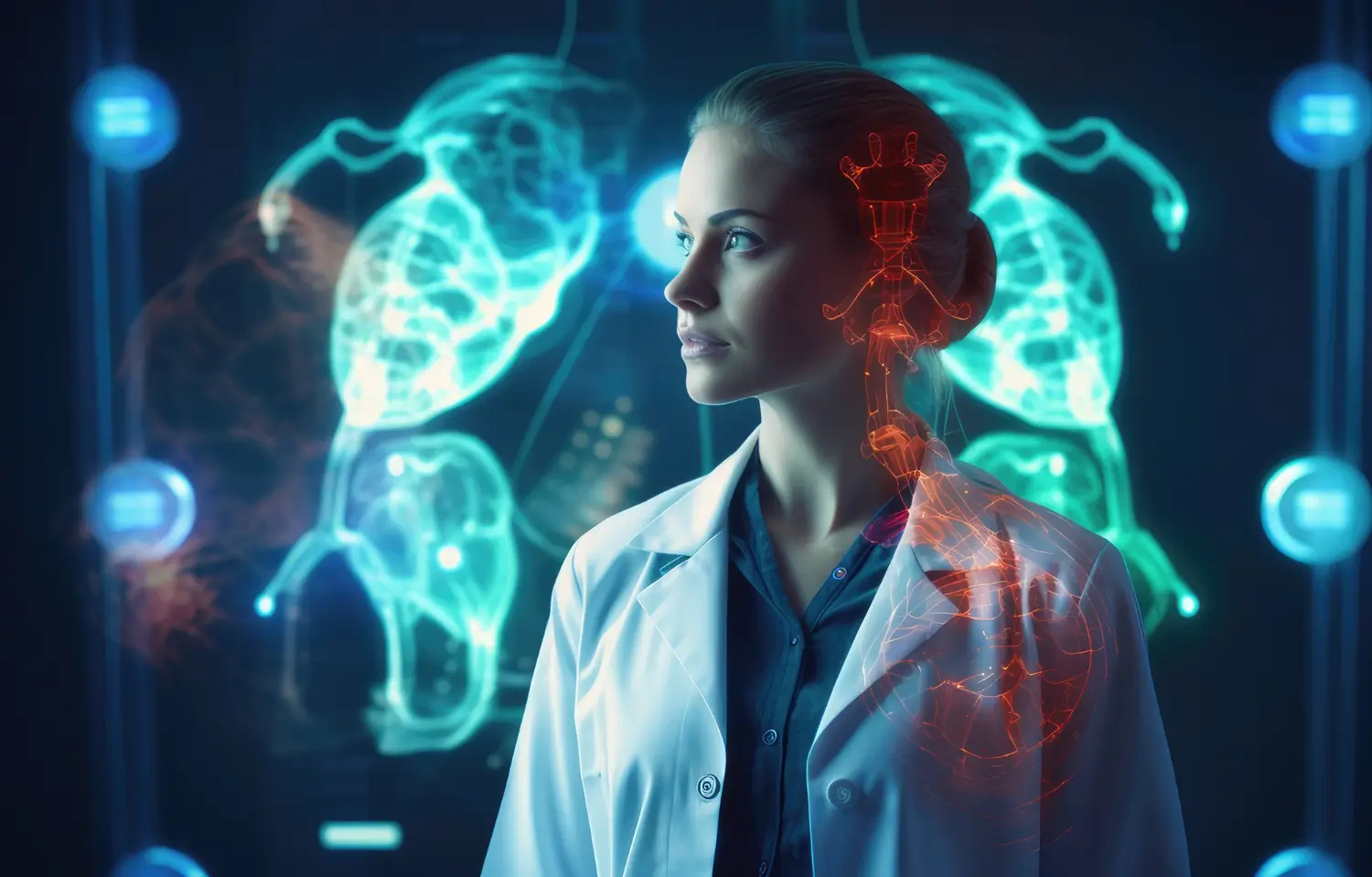Table of Contents
Imagine a world where every diagnosis is precise, every treatment is tailored, and patient care is transformed by the power of advanced artificial intelligence technologies. This is not the future—it’s happening right now as generative AI revolutionizes how we approach healthcare.
This cutting-edge technology helps tackle persistent issues like rising healthcare costs and the global shortage of healthcare professionals, among many others. Moreover, 92% of leaders in the industry believe generative AI can improve efficiency, and 65% think it can enable faster decision-making.
But how can you utilize generative AI in healthcare?
In this guide, we’ll explore the different AI technologies you can use in this field, how to implement them, and some real-life examples of generative AI in action.
What is Generative AI?
Generative AI refers to advanced algorithms capable of creating text, images, video, or audio content from existing data sets. This technology leverages machine learning models like:
- Transformer models: Transformer models like GPT, known for their deep learning capabilities, excel in natural language processing. They analyze vast amounts of data and generate various types of text and image content across multimodal applications.
- Stable diffusion: Known for generating detailed images from textual descriptions, this model supports creative applications such as image-to-image translation and inpainting, providing tools for innovative visual content creation.
- Variational autoencoders (VAEs): These models are crucial for tasks that require high levels of accuracy and creativity in image generation and style transformation, making them invaluable in medical imaging and data augmentation.
Generative AI in Healthcare
Generative AI development in healthcare is significantly enhancing both administrative and clinical operations. By analyzing unstructured data, such as clinical notes or imaging, AI can:
- Generate accurate documentation
- Support decision-making
- Optimize patient management
- Enhance diagnostic processes
- Accelerate the creation and analysis of new drugs
These advancements are often driven by the expertise of medical imaging AI software developers, who help build intelligent systems capable of interpreting complex medical data and supporting clinical workflows.
For instance, by leveraging large language models (LLMs), healthcare providers can reduce the administrative load by automating the creation of clinician notes from patient interactions. This can save time, improve the accuracy of patient records, and provide comprehensive post-visit summaries, increasing the efficacy of follow-up care and patient comprehension.
How Does Generative AI Make Headway in Healthcare?
Major IT organizations are leveraging the incredible power of AI to redefine medical practices and patient care.
Industry leaders like OpenAI, Google, and Microsoft are not just participants but trailblazers in this transformation. Here’s how these powerhouses are making significant strides in the field of generative AI, setting new standards for healthcare innovation.
With MedLM, part of Google Cloud’s suite available to select U.S. customers, Google is enhancing healthcare interactions. MedLM’s models, built on the Med-PaLM 2 foundation, can tackle various tasks, significantly improving the automation of medical documentation.
A notable collaboration between Google and HCA Healthcare has birthed a pilot program across four emergency departments. Utilizing the Augmedix platform on hands-free devices, this program allows physicians to convert conversations into draft medical notes via MedLM’s capabilities. These drafts are refined by clinicians before being integrated into the hospital’s electronic health record (EHR) system, streamlining documentation and improving accuracy.

OpenAI
OpenAI is focused on integrating generative AI into health behavior change interventions. Utilizing advanced tools like ChatGPT and GPT-4, OpenAI is revolutionizing how health-related behaviors are assessed, managed, and modified.
These AI-driven interventions have the potential to combat non-communicable diseases by encouraging healthier lifestyle choices through personalized digital communication.
According to recent studies, AI chatbots can also promote critical health behaviors, including medication adherence and smoking cessation. However, challenges such as data input burdens, the need for broader, more diverse trial data, and the ethical application of AI in health interventions persist.
Anthropic's Claude LLM and Amazon
With a substantial investment in Anthropic, Amazon has integrated Claude LLM into its healthcare services, enhancing tools like Amazon Bedrock and AWS HealthImaging. Through the right AWS partner solutions, this integration allows healthcare organizations to streamline clinical documentation, data analysis, and patient management.
Claude LLM, a direct competitor to OpenAI’s models, is known for its safety and reliability. It supports healthcare professionals by automating administrative tasks and providing insights that improve patient care. These advances are part of a broader effort to leverage AI in tackling the pressing challenges of healthcare, offering more accurate diagnoses, efficient operations, and personalized patient interactions.
Microsoft
In collaboration with leading health institutions like Stanford Medicine and WellSpan Health, Microsoft has introduced the Nuance Dragon Ambient eXperience Copilot (DAX Copilot). This tool employs generative AI to streamline clinical documentation, significantly enhancing efficiency and clinician satisfaction by automating note-taking processes.
Further, Microsoft’s partnership with Providence leverages its Azure cloud platform to foster AI innovation, improving interoperability and care delivery across the health system.
Microsoft continues to expand its influence by actively participating in the Trustworthy & Responsible AI Network (TRAIN), promoting safe and ethical generative AI applications in healthcare. This supports healthcare providers with tools that integrate AI responsibly into their daily operations, setting a standard for future healthcare technologies.
Regulatory and Ethical Considerations
As generative AI reshapes healthcare, maintaining rigorous ethical and regulatory standards is critical. Here, we delve into the main standards AI applications in healthcare need to follow:
- Privacy and data security: The protection of sensitive health data is paramount. Adhering to regulations like HIPAA is just the beginning. Generative AI applications must incorporate advanced security measures to prevent data breaches. These efforts are in line with the World Health Organization’s recent guidelines, which advocate for robust data protection protocols.
- Ethical AI use: Bias in AI is a hot topic, especially in healthcare where decisions affect patient lives. AI solutions designed to minimize bias by training on diverse datasets ensures equitable care across all patient demographics. This approach aligns with global standards, including those proposed in the WHO guidelines that stress inclusivity and fairness.
- Regulatory compliance: AI’s rapid evolution challenges existing healthcare regulations. Active collaboration with regulatory bodies is vital to ensure AI tools not only push the envelope in innovation but also strictly adhere to health regulations. This collaborative approach is supported by industry leaders, supporting WHO’s new guidelines, as they recognize the importance of keeping patient safety at the forefront.
- Integrating with healthcare stakeholders: True to the WHO’s recommendations, engaging a broad spectrum of stakeholders in the AI solution development helps address real needs and ethical considerations.
- Monitoring impact and adjusting practices: Continuous monitoring of AI’s impact in healthcare settings involves not just assessing performance against health outcomes but also ensuring that these technologies do not replace the essential human touch in healthcare. Tools like Hugging Face’s benchmark tests are instrumental in evaluating the practical effectiveness and safety of AI applications.

Applications of Generative AI in Healthcare (+ Real-life Examples)
Generative AI leverages vast datasets to reshape personalized medicine and streamline healthcare operations. Let’s explore some compelling generative AI examples in healthcare, showcasing the diverse applications within the sector:
Enhancing Diagnostic Accuracy
Medical specialists use generative AI in radiology to analyze complex medical images and predict disease progression.
By integrating these AI models with diagnostic processes, healthcare providers can detect conditions earlier and with greater precision, tailoring treatment plans to individual patient needs.
Additionally, these AI systems can play a critical role in matching patients with the most appropriate clinical trials, which enhances the potential for better outcomes.
“At The Alignment Studio, we’ve integrated AI-driven movement analysis tools to assess patients’ biomechanics more accurately, allowing us to create highly tailored rehabilitation programs. By using AI powered gait and posture assessment software, we can detect subtle imbalances and inefficiencies in movement that might be missed by the human eye. This has streamlined our approach to physical therapy, allowing us to provide targeted interventions faster, reducing recovery times and enhancing patient outcomes“
– Peter Hunt, Director & Physiotherapist
Healthcare Process Automation
Routine tasks such as data entry, appointment scheduling, and clinical documentation consume significant time and resources in healthcare settings.
Generative AI steps in as a game-changer by automating these tasks, which allows healthcare professionals to focus on direct patient care and decision-making.
Example: The Cleveland Clinic uses specialized AI assistance in predicting patient inflow, managing resource allocation, and even generating medical notes from doctor-patient conversations.
Drug Discovery and Development
In drug development, generative AI accelerates the identification of promising drug candidates and optimizes formulations. This can drastically cut down the time and cost associated with bringing new drugs to market.
By predicting how different chemicals will interact, AI models can simulate countless scenarios quickly, uncovering potential treatments that might have otherwise gone unnoticed.
Example: Companies like Atomwise and Exscientia leverage generative AI to accelerate the process of drug design and discovery.
Enhanced Patient Care through Gen-AI Powered Chatbots
Chatbots powered by generative AI are enhancing patient care by providing 24/7 responses to inquiries, offering personalized health advice, and supporting chronic disease management. These AI-enhanced interactions not only improve patient engagement but also ensure continuous monitoring and support, especially for those managing long-term health conditions.
Example: Mass General Brigham utilized a generative AI-powered chatbot developed by Providence during the COVID-19 pandemic. This AI efficiently managed inquiries, offering health assessments and directing patients to the appropriate care.
Precision in Clinical Documentation
By analyzing voice and text data from patient interactions, AI can generate detailed, accurate clinical notes that are integrated directly into EHRs. This precision helps maintain consistent and comprehensive patient records, which are crucial for ongoing care and treatment planning.
Example: Mayo Clinic has partnered with Cerebras Systems to leverage AI in analyzing vast amounts of medical data for better patient care. This collaboration focuses on creating AI-driven tools for summarizing patient records and analyzing medical imagery and genomic data, which aid in making precise treatment decisions tailored to individual patient needs.
Improvement of EHR Systems
LLMs are revolutionizing EHR systems by enhancing the extraction and interpretation of data from patient records. EHR system development that incorporates AI models creates solutions that help analyze unstructured data and pull meaningful insights from doctors’ notes, laboratory results, and historical health records, which can significantly enhance decision support systems within EHRs.
Example: Epic is enhancing EHR systems by integrating generative AI to automate routine tasks like responding to patient portal messages and summarizing recent patient information. This technology allows healthcare providers to spend more time with patients by quickly drafting responses and synthesizing essential updates, which clinicians can review and customize before communicating with the patient.
Steps to Implement Generative AI in Healthcare
Integrating generative AI into healthcare can enhance efficiency, accuracy, and patient care, but the process requires careful planning and execution. Here’s a step-by-step process for healthcare organizations considering adopting generative AI technologies.
Assessment of Needs
You can begin by conducting a thorough assessment of your organization’s specific needs and readiness for integrating AI. This entails:
- Evaluating which areas of your operations could benefit most from AI, such as diagnostics, administrative tasks, or patient engagement.
- Understanding the challenges and limitations of your current systems to identify where AI can make the most significant impact.
Custom Development vs. Off-the-Shelf Solutions
Choosing between custom-developed AI solutions and off-the-shelf products depends on several factors, such as:
- Specific organizational needs
- Budget constraints
- Scalability requirements
- The urgency of deployment
For example, bespoke solutions and AI product development offer tailored features that align closely with specific organizational needs but can be costly and time-consuming to develop. On the other hand, off-the-shelf solutions are generally more cost-effective and quicker to deploy but may require compromises on the fit and functionality specific to your operations.
Data Governance and Compliance
Ensure that your AI implementation complies with all relevant health data regulations, including HIPAA in the U.S., GDPR in Europe, or others applicable to your region.
Establish robust data governance policies to manage data integrity, confidentiality, and access. This step is crucial for maintaining trust and ensuring that patient information is handled securely.
Stakeholder Engagement
Engage stakeholders from across the organization early in the process, including IT, clinical staff, and administrative personnel. Their insights will be invaluable in identifying the practical needs and concerns that could impact the AI integration. Their buy-in is critical for smooth adoption and operational integration.
Pilot Projects
Start with pilot projects to test the waters before a full-scale rollout.
Select a department or process where generative AI can have a visible impact and monitor the results closely. This will help you understand the practical challenges and potential benefits without the commitment of full-scale implementation.
Training and Support
Plan comprehensive training sessions for all users to ensure they are comfortable and proficient with the new AI tools. Include ongoing support to address any issues as they arise, which will help mitigate resistance and increase user confidence in using AI systems.

Scaling and Optimization
After successful pilot projects, plan a gradual rollout to other parts of the organization, adjusting strategies based on feedback and outcomes from earlier phases. Continuously monitor the AI systems for performance and make adjustments to improve functionality and efficiency.

Continuous Evaluation
Implement mechanisms for the ongoing evaluation of AI performance against set objectives, such as:
- Accuracy
- Efficiency
- User satisfaction
- Return on investment
Regular reviews and updates based on the latest AI advancements and organizational feedback will help maintain the relevance and effectiveness of your AI solutions.

Choosing Technology Partner for Generative AI Needs
As healthcare organizations look to harness the transformative power of generative AI, selecting the right development partner becomes critical. A skilled partner can bridge the gap between current capabilities and innovative goals, ensuring the successful integration of AI technologies.
Benefits of Partnership
Partnering with a seasoned AI development company brings numerous advantages like:
- Access to specialized expertise in AI development and integration, which is crucial for leveraging advanced AI technologies effectively.
- The option to create customized solutions that align with your specific needs, driving efficiency and innovation in patient care and operational processes.
- Creating a scalable and sustainable AI solution that adapts to evolving healthcare challenges and technological advancements.
What to Look for in a Partner
When selecting a technology partner for generative AI, there are several key criteria to consider:
- Expertise in healthcare AI: Look for AI development companies with a strong background in healthcare AI. They should have a deep understanding of the medical domain, including the specific challenges and requirements of healthcare applications.
- Compliance with healthcare regulations: It’s crucial that your partner is well-versed in healthcare regulations and other relevant frameworks. They must ensure that all AI solutions comply with these regulations to protect patient data and privacy.
- Proven track record: Evaluate potential partners based on their past projects and successes in the healthcare sector. A partner with a proven track record demonstrates their ability to deliver effective solutions and navigate the complex landscape of healthcare IT.
- Innovative approach: Your chosen partner should not only be technically proficient but also innovative in their approach to solving problems. They should be able to provide insights into new applications of generative AI in healthcare for your specific needs.
- Support and scalability: Effective partners provide ongoing support and are committed to evolving their services to meet your growing needs. Scalability is key to accommodating the expanding use of generative and conversational AI in healthcare.
- Cultural fit: Finally, ensure that your partner aligns with your organization’s culture and values. A partner that matches your work style and ethos will facilitate smoother interactions and more productive collaboration.
Our AI Expertise in Healthcare
At Scopic, we harness the power of generative AI to develop transformative healthcare solutions that not only meet but exceed the demands of modern medical practices and patient care. Here’s a snapshot of our innovative generative AI solutions:
Orthoselect
Scopic partnered with Orthoselect, a leader in orthodontic solutions, to transform its treatment planning through innovative AI technology.
Together, we developed a desktop application that generates accurate 3D models of patients’ teeth using a custom-built deep learning solution. Trained on 1,200 labeled datasets for precise teeth segmentation, this AI model has significantly improved the accuracy and efficiency of treatment planning. This enabled Orthoselect to offer customized orthodontic solutions that meet the unique needs of each patient.

Chitolytic
Scopic collaborated with ChitoLytic to develop an innovative AI-driven chatbot assistant tailored for the chitosan industry.
Utilizing advanced models like GPT-4 and GPT-4-turbo, integrated through LangChain, LangServe, and LangSmith technologies, the ChitoGuide chatbot provides detailed insights into chitosan chemistry, applications, and modifications. This enables it to simplify complex scientific concepts, making them accessible to a broad audience.
The chatbot is deployed via a Lambda function and features a user-friendly interface crafted in VoiceFlow.
Final Thoughts
Generative AI is rapidly transforming healthcare, enhancing diagnostic accuracy, automating processes, and personalizing patient care. Its capabilities in analyzing vast datasets and generating actionable insights are vital for healthcare organizations aiming to innovate and improve efficiency. As the landscape of healthcare continues to evolve, integrating generative AI into your digital transformation strategy could be a game-changer.
Explore how Scopic’s expertise in generative AI development can help you optimize your healthcare solutions and stay ahead in a competitive market.

About Creating Generative AI in Healthcare Guide
This guide was authored by Vesselina Lezginov, and reviewed by Tim Burr, Founder and CEO of Scopic.
Scopic provides quality and informative content, powered by our deep-rooted expertise in software development. Our team of content writers and experts have great knowledge in the latest software technologies, allowing them to break down even the most complex topics in the field. They also know how to tackle topics from a wide range of industries, capture their essence, and deliver valuable content across all digital platforms.
Note: This blog’s images are sourced from Freepik.





